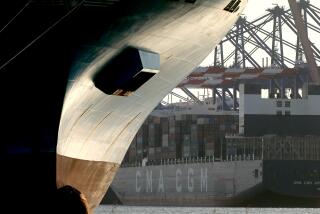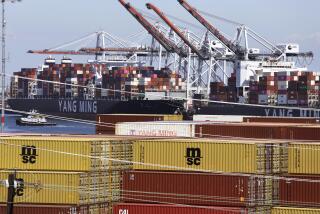‘Deflagging’ Plan by U.S. Shipping Firm Imperils L.A. Sea Jobs
American President Lines has had a long and proud presence in international trade, hauling cargo across the oceans as the United States’ second-largest shipping company. But in a move some call unpatriotic, APL is heading for the Marshall Islands.
Six new container ships to be added to the APL fleet by December will be registered in the islands under a waiver granted by the Maritime Administration in Washington.
The six C-11 ships will replace five older vessels and carry foreign crews, eliminating 300 to 400 jobs held by American seamen--half of them Los Angeles workers, union officials say. The ships will cross the Pacific and make regular calls at the $150-million APL container terminal being built by the Port of Los Angeles, but they will not fly the American flag.
APL, a $2.5-billion-a-year publicly held company, also is expected to begin reflagging its existing fleet.
Maritime labor unions, whose members recently demonstrated outside APL’s Oakland headquarters to protest the change, say it is hypocritical because APL has benefited over the years from a federal subsidy program. Industry officials say APL’s move is part of a trend to register ships under foreign flags, further diminishing America’s merchant marine fleet.
The unions say the waiver granted to APL violates the Merchant Marine Act of 1936, enacted to encourage American-owned shipping lines to operate under the U.S. flag and employ American crewmen. Led by the Seafarers International Union and the Marine Fireman’s Union, they have filed suit against APL, Maritime Administrator Albert J. Herberger and Secretary of Transportation Federico Pena.
The suit notes that APL’s current 19-ship fleet receives a subsidy of $60 million to $70 million a year from the federal government to help it compete with foreign carriers whose labor costs are cheaper.
“Here’s a company that just can’t get subsidized enough,” said Cecil McIntyre, spokesman for the Marine Engineers Beneficial Assn. in San Pedro. “They’ve been getting rich off the taxpayers for four years, and now they’re turning their backs on American crews.”
McIntyre said that if the union challenge fails, a subsidized carrier will be allowed to operate a mixed fleet of U.S. and foreign-registered vessels for the first time.
American shipping lines have expressed more interest in operating under foreign flags and with foreign employees since the Clinton Administration’s decision to end the $215-million-a-year subsidy program in 1997 and begin smaller subsidies. The companies, which employ about 20,000 people, contend that without the larger subsidies, they cannot afford higher American labor and shipbuilding costs and remain competitive with foreign companies.
“It costs $3 million to $4 million more per year, per ship, to operate under the U.S. flag,” APL spokesman Gil Roeder said. “We can’t be competitive under the U.S. flag in an environment where there’s no government program that supports using U.S. crews. We can’t earn an adequate return on equity or return on our investments.”
If APL had not received its waiver, Roeder said, “then we basically would have had to either look at foreign ownership of the vessels or operate them in a non-U.S. trade.”
Sea-Land Services--the nation’s largest commercial shipping company--operates its vessels under U.S. registry without subsidy. But it, too, has requested permission to reflag four ships in its 25-ship fleet.
The commercial shipping industry has long complained about high U.S. taxes and costly Coast Guard standards.
By registering in the Marshall Islands, APL saved nearly $60 million in lower construction costs on the six C-11s, said Gene Pentimonti, vice president of APL Government Services. The $535-million project is being done in South Korea and Germany.
*
In an effort to reach a compromise over subsidies, Transportation Secretary Pena sent a bill to Congress earlier this month outlining a smaller, reformed maritime subsidy program. But because it would subsidize fewer ships, it would not stop the diminution of America’s merchant fleet, Maritime Administration spokesman John Swank said.
The nation’s merchant marine has declined by about a quarter since the 1950s, when it boasted more than 1,200 privately owned, although smaller, vessels. Today, in a country that depends on ocean transportation for about 90% of its foreign trade, only 5% of the vessels that enter U.S. ports are registered in the United States.
More to Read
Sign up for Essential California
The most important California stories and recommendations in your inbox every morning.
You may occasionally receive promotional content from the Los Angeles Times.









